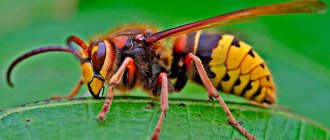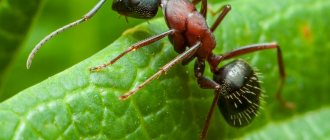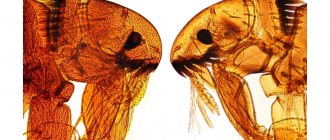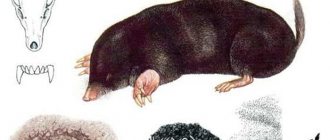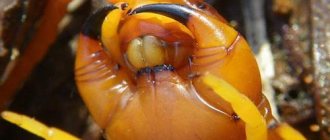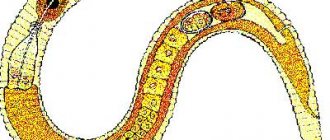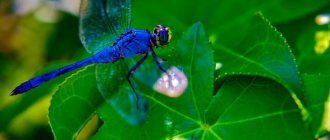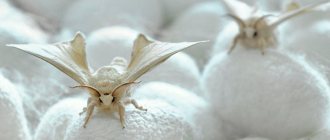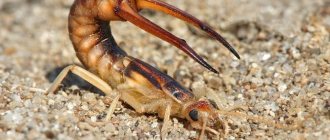- Wild animals
- >>
- Insects
The dragonfly is an arthropod insect with six legs, belonging to the subclass of winged insects, the order of dragonflies. The order of dragonflies currently includes more than 6,650 species of these insects. Dragonflies are fairly large predatory insects that have a movable head, large eyes, a long and slender abdomen and four transparent wings. They are found all over the world, with the exception of cold Antarctica.
Origin of the species and description
Photo: Dragonfly
Odonata or dragonflies are predatory insects belonging to the phylum Arthropoda, subclass of winged insects and order Dragonfly. This detachment was first described by Fabricius in 1793. Dragonflies are a very large order, which includes 6,650 species. Currently, 608 species are classified as extinct, and 5899 species of these insects inhabit our planet in modern times.
The dragonfly order is divided into 3 suborders:
- heteroptera;
- Homoptera;
- anisozygoptera.
Dragonflies are a very ancient group of insects. The first dragonflies inhabited the earth back in the Carboniferous period of the Paleozoic era. These insects are descended from the giant dragonfly-like insects Meganeura. Meganeuras were large insects with a wingspan of up to 66 cm. These insects were considered the largest insects of ancient times. Meganeura later gave birth to the following groups of their descendants: Kennedyina and Ditaxineurina, these groups of insects lived in the Triassic period of the Mesozoic era. They were large; the wings of these insects were about 9 cm long. During rest, they folded under the abdomen of the insect.
Video: Dragonfly
The insect also developed a trapping basket, used for grasping prey. During the Jurassic period, the following groups came: Lestomorpha and Libellulomorpha in these insects, the larvae developed in an aquatic environment and they had an improved flying apparatus. Insects of the Libellulida group inhabited Africa, South America and Australia in the Triassic period. Meganeuras still lived in Eurasia at that time, but during the course of evolution their bodies and habits changed. In the Jurassic period, meganeurins reached the pinnacle of evolution and populated all of Eurasia. These insects had a “catching basket” and could use it to hunt during flight. Gas exchange in this group was carried out using the respiratory epithelium, but there were also lamellar gills, which changed over time, ceased to perform a gas exchange function and were replaced by internal gills.
At the same time, the descendants of the family Calopterygoidea have evolved greatly from the original state. The wings of these insects narrowed, became stalked and the size of the wings became the same. In the Jurassic period, insects of the suborder Anisozygoptera become the most common; their numbers sharply decrease during the Cretaceous period, but this group remains widespread throughout the entire polygenic period. During this period, such species of dragonflies as Coenagrionidae, Lestidae and Libelluloidea, etc. almost disappear. The Cenozoic fauna is already inhabited by modern species of dragonflies. During the Neocene, the ethnofauna was no different from the modern one. The Zygoptera population declined sharply, but Coenagrionidae and Lestidae became the most common species.
Nutrition of larvae
We know what dragonflies eat, but it becomes interesting what their larvae eat. It turns out that they are very voracious, just like adults. In addition, like dragonflies, they are predators - they are content exclusively with live prey. The younger the individual, the more food it requires.
The difference from adult insects is that the larvae, hiding, patiently wait for their prey, and when the opportunity arises, they attack it with lightning speed. Daphnia, mosquitoes and other insects are the inhabitants of the reservoir that provide the main food for small dragonflies.
Having learned what dragonflies and their larvae eat, it is easy to draw a conclusion about the benefits of insects in nature. But this mysterious individual has another secret, which must be revealed at least in order to obtain more complete information about the insect.
We remember what kind of life they lead, what dragonflies eat, and where their larvae live. But it turns out that the lifespan of individuals under water is much longer than that on the surface. The larva is able to live under water for about five years, while the adult insect exists for only 6-7 months.
Dragonflies (lat. Odonata) are a detachment of predatory insects that can fly well. This order includes more than 5,000 species, the vast majority of which live in the tropical and humid subtropical zones. In Russia and Ukraine, dragonflies are distributed everywhere, except in areas with arid climates. There are about 150 species. According to classification, the order of dragonflies is divided into three suborders: heteroptera (grandmothers, rockers), homoptera (loves, arrows, beauties) and Anisozygoptera. Fossil records of dragonflies date back to the early Triassic period.
Dragonflies feed on other insects, capturing prey in flight. They eat midges, mosquitoes and some other pests.
Development
. The development cycle of these insects is with incomplete transformation. Dragonflies mate in flight. Eggs are laid in a moist environment (in aquatic plants, directly in water, in moist soil). The larvae are called naiads. Their development takes place in water. Breathing through the gills. A distinctive feature of naiads is their excessively long lower lip, which forms a grasping apparatus - a mask. In the process of capturing prey, it sharply moves forward, and at rest closes its head from below. The larvae also lead a predatory lifestyle. Their food is larvae of aquatic insects, sometimes fish fry, and tadpoles. In the food chain, naiads are also often preyed on by fish. Upon completion of development, the larvae emerge from water bodies and attach to objects on land. This is where the final molt occurs during transformation into the adult. Eggs and naiads survive the winter period.
Structure
. External structure of the imago. The body dimensions range from 1.5 mm to 12 cm, the wing length can be up to 9 cm. The abdomen of dragonflies is elongated, slender, usually brightly colored and shiny. On the moving head of the individual, large compound eyes and short bristle-like antennae are clearly visible. The special structure of the visual apparatus helps dragonflies better navigate in the surrounding space. Each eye consists of at least 30 thousand facets. The upper facets distinguish colors, while the lower ones determine exclusively the shape of objects. For better orientation, these insects have the ability to see in the infrared range.
Wings
. Two pairs of transparent wings with a dense network of veins are attached to the chest. Representatives of homoptera dragonflies have fore and hind wings of almost the same shape, narrow, at rest they are above the body and pressed against each other. Different-winged dragonflies are distinguished by the fact that their wings are of different shapes, with the base of the rear pair being wider. At rest they seem to be apart. When flying, dragonflies flap their front and rear wings in turn, thereby gaining greater speed and improving flight maneuverability. Thus, dragonflies reach a maximum flight speed of 50 km/h.
Meaning
. In nature, they occupy an important place in food chains. They are useful for humans because they eat many harmful insects (mosquitoes, midges). But they can be carriers of a dangerous infectious disease of poultry – protagonimiasis. Dragonfly larvae can cause harm by eating the fry of commercial fish in fish farms.
The message about the dragonfly, a six-legged arthropod insect, will tell you about its full characteristics.
Report about the dragonfly
General information about dragonflies
Dragonflies are difficult to confuse with other insects. They have a bright and shiny color, a large head and powerful wings. The insect's head is movably connected to the chest. This gives it the ability to rotate 180 0 around its axis.
The dragonfly's eyes occupy most of the head and consist of 30,000 small facets - small ocelli. They work independently of each other. The upper part of the facets recognizes shapes, and the lower part recognizes the colors of objects. A dragonfly can spot prey at a distance of up to 8 m.
The insect's mouth is armed with jaws and for good reason, because they are voracious predators. The chest consists of a front chest with one pair of limbs and a back chest with legs.
They have 2 pairs of wings, which can be either the same or different in size. Wingspan up to 18 cm.
How long do dragonflies live?
The average lifespan of an insect is 10 months. Many species die after 6 weeks. But long-livers can wait out unfavorable conditions in shelters.
What types of dragonflies are there?
Scientists have now described more than 6,000 species of dragonflies. We suggest viewing only the most common species.
Dragonfly species:
- Dragonfly Watcher-Emperor
- Dragonfly cordulegaster ringed
- Dragonfly metal headstock
- Common dragonfly Dedka
- Common dragonfly
- Dragonfly Beauty girl
- Dragonfly Arrow southern
- Lute Dryad Dragonfly
- Dragonfly Megaloprepus caerulatus (world's largest)
Where do dragonflies live?
They can be found in any area of the world where the weather is warm and there is plenty of water and food. The habitat of dragonflies is Russia and Belarus, Germany and France, Italy and Spain, the countries of the Balkan Peninsula. Some species of dragonflies are found in Pakistan and India, Azerbaijan and Thailand, Iran and Armenia, China and Turkey.
What do dragonflies eat?
Dragonflies are typical predators that catch their prey on the fly. The main food of insects is mosquitoes, flies, and moths. Large representatives can eat spiders, small fish, and frogs.
Dragonflies interesting facts
- Dragonflies can live underwater for two years. And in the larval state even six years.
- Before acquiring the beautiful color that we are used to seeing, dragonflies molt about 17 times.
- In 2009, the world's first dragonfly sanctuary, the Dragonfly Center, opened. In it, scientists managed to increase the number of 42 species of these insects inhabiting the UK.
- A dragonfly's eyes cover a 360° area in its field of vision.
- The dragonfly is naturally completely deaf.
- She can turn her head in any direction.
We hope the information presented about dragonflies has helped you. You can leave your short story about the dragonfly using the comment form.
Dragonflies are considered the most ancient insects on our planet. Once upon a time, these insects were simply gigantic in size - the length of their wingspan was up to 90 cm.
But over time and changes in living conditions, the size of dragonflies gradually decreased, and now the length of the wingspan of the largest representative of the order Odonata does not exceed 20 cm.
Appearance and features
Photo: What a dragonfly looks like
All dragonflies have a very recognizable appearance. The coloring of these insects may vary.
The insect's body secretes:
- head with big eyes;
- brightly colored shiny body;
- breast;
- transparent wings.
These insects, depending on the species, can be of different sizes: the smallest dragonflies are 15 mm long, and the largest are about 10 cm long. The head is large and can rotate 180°. On the head of the dragonfly there are eyes, which consist of a large number of ommatidia, their number ranges from 10 to 27.5 thousand. The lower ommathia can perceive only colors, and the upper ones only the shapes of objects. Thanks to this feature, the dragonfly can navigate well and easily find prey. The parietal part is swollen, with three ocelli located on the crown. The dragonfly's antennae are short, awl-shaped and consist of 4-7 segments.
The mouth is powerful, formed by two unpaired lips - upper and lower. The lower lip consists of 3 lobes and covers the powerful lower jaws. The upper one has the shape of a short plate, which is elongated in the transverse direction; it covers the upper jaw. The lower lip is larger than the upper lip, thanks to which the insect can chew prey during flight.
The chest consists of 3 sections: prothorax, metathorax and mesothorax. On each part of the chest there is a pair of limbs, and on the middle and back parts there are insect wings. The front part is separated from the middle part. The middle and back parts of the chest are fused and form a synthorax, which is perceived as the chest. The shape of the chest is flattened from the sides, the part of the chest located on the back is pushed back. The mesothorax is located above the metathorax, causing the wings to intertwine behind the legs. The pronotum is divided into 3 lobes; there is usually a depression on the middle lobe. The segments on which the wings are located are hypertrophied pleurites.
The wings are transparent, consist of two chitinous layers, each of them is formed by its own system of veins. These veins overlap each other, so the network of them appears to be one. The venation is complex and dense. Different orders of these insects have different venation systems.
The dragonfly's abdomen is mostly round and elongated. In rare species it is flat. The abdomen makes up most of the insect's body. Consists of 10 segments. On the sides there are pleural membranes that allow the dragonfly to bend. All segments besides 9 and 10 have one sigma. At the end of the abdomen there are anal appendages: females have 2, males have 3-4. In females, the genitals are located at the end of the abdomen; in males, the compilatory organ is located on the 2nd segment of the abdomen, the vas deferens is located on the tenth segment of the abdomen. The limbs are strong and developed and consist of: thigh, coxa, tibia, vetluga, and tarsus. There are spines on the limbs.
Dragonflies are some of the smartest killers in the insect world
The dynamics of catching an object in the air are staggeringly complex, so complex that only animals with complex nervous systems, such as seagulls or humans, can catch objects in the air. To catch something moving at speed, you will have to guess where it will be some time in the future. When scientists began studying dragonflies in 1999, they learned that dragonflies don't "track" their prey by flying through the air, they "intercept" it. In other words, dragonflies ensure a precise kill of the prey by flying to where the prey will be after some time.
This indicates that dragonflies calculate three things when hunting: the distance to their prey, the direction in which it is moving, and the speed at which it is flying. Within milliseconds, the dragonfly calculates the angle from which it should approach, and, like in a horror film, the unfortunate victim is already waiting on the spot, who flies into its claws, without knowing it.
Where does the dragonfly live?
Photo: Pink dragonfly
Dragonflies are widespread throughout the world. These insects cannot be found, probably, only in Antarctica. A special variety of species of these insects can be found in the Indo-Malayan zone. About 1,664 species of dragonflies live there. There are 1,640 species in the Neotropics. And also, dragonflies love to settle in the Afrotropics; about 889 species live there; in the Australian region there are about 870 species.
In countries with a temperate climate, fewer species of dragonflies live, this is explained by the heat-loving nature of these insects. There are 560 species in the Palearctic and 451 species in the Nearctic. To live, these insects choose places with a warm and humid climate. The presence of a reservoir is very important for dragonflies; during the mating season, the female lays eggs in water, eggs and larvae develop in an aquatic environment. Depending on the species, dragonflies have different attitudes towards the choice of reservoirs and the need to live near water. For example, dragonflies of the species Pseudostigmatinae are content with small water reservoirs in the undergrowth. They can use small ponds, lakes or flooded pits for breeding. Other species live near rivers, ponds and lakes.
The larvae spend their lives in water, and adults, having learned to fly, can fly long distances. Found in meadows and forest edges. Dragonflies love to soak up the sun, this is very important to them. With the onset of cold weather, dragonflies fly to countries with warmer climates. Some dragonflies fly up to 2900 km. Sometimes dragonflies migrate in especially large numbers. Flocks numbering up to 100 million thousand individuals have been observed. But more often, dragonflies do not flock together, but fly alone.
Now you know where the dragonfly lives. Let's see what she eats.
Habitat
All animals settle in places where conditions are favorable for them. Dragonflies live almost everywhere. But the main factor in their habitat is the humid climate. Therefore, you can find dragonflies near rivers and lakes. A wide variety of them live in tropical and subtropical climates.
Beetles live everywhere. There are especially many of them in the tropical regions of the planet. You cannot find them in the Arctic and Antarctica. They live in small numbers on mountain tops. Bed bugs also live everywhere. Some species can be found even beyond the Arctic Circle.
What does a dragonfly eat?
Photo: Dragonfly in nature
Dragonflies are predatory insects. Adults feed on almost all types of insects inhabiting the air.
The diet of dragonflies includes:
- mosquitoes;
- flies and midges;
- mole;
- beetles;
- spiders;
- small fish;
- other dragonflies.
Dragonfly larvae feed on mosquito and fly larvae, small crustaceans, and fish fry.
Based on their hunting methods, these insects are divided into several subspecies:
- free hunters who hunt in the upper tier. This group includes species of dragonflies with powerful and developed wings that can fly well and quickly. These species may use school hunting, but more often hunt alone at heights from 2 to 9 meters above the ground;
- free-flying predators hunting in the middle tier. These dragonflies hunt at heights of up to 2 meters. They are always in search of food; to rest, they can sit on the grass for a few minutes, and then begin to hunt again;
- dragonflies lying in wait. This species is distinguished by its unusual way of hunting. They sit quietly on the leaves or stems of plants, looking out for prey, from time to time breaking off to attack;
- dragonflies living in the lower tier. These dragonflies hunt in thickets of grass. They flutter slowly from one plant to another in search of insects that are sitting on the plant. This species eats prey while sitting on a plant, and does not eat while flying.
Interesting fact: Cannibalism is very common among all species of dragonflies. Adult dragonflies can eat smaller dragonflies and larvae. Sometimes females after mating can attack the male and eat him.
Ecological and biological characteristics of dragonflies, species
Eggs are laid in the tissue of aquatic plants. Often up to 50-70 eggs are laid on one plant, which are placed in a straight line up to 40 cm long. In autumn, these plants die and, together with the laid eggs, fall into the water.
The larvae emerge from the eggs in the spring. The development of larvae is completed in 8 - 10 weeks.
Beauties (Calopterygidae)
The beauties are perhaps truly the most beautiful dragonflies. Males differ from females by darkened wings. These dragonflies are very rare in the Baikal region and deserve protection.
Splendid beauty (Calopteryx splendens)
Lutki (Lestidae)
The lute family (Lestidae) includes small homoptera dragonflies, but with a long pterostigma.
Near any stagnant bodies of water, the dryad lute (Lestes dryas) is very common. A similar species, the bride lute (L. sponsa), differs reliably only in the structure of the genital appendages. Females are lighter in color.
Lute dryad (Lestes dryas)
Small, poorly flying lute and arrowheads feed on mosquitoes and other small insects.
They themselves can become victims of large dragonflies, birds, or even insectivorous plants, like this lute that fell into the clutches of the English sundew.
Among the aquatic thickets, graceful nymphs of lute (Lestes) are found in large numbers. Their thin body bears three tail leaves at the end. When nymphs swim by bending their long body from side to side, the vertical tail leaves act as a fin.
They are easily broken off, or even discarded by the larva, like a lizard's tail. Without them, animals move awkwardly and slowly until the next molt, when the tail leaves are restored. Lying nymphs are very dangerous for any small living creatures - crustaceans, worms, insect larvae and for their younger brothers.
Rocker (Aeschnidae)
Our largest dragonflies belong to the rocker flies (Aeschnidae).
One of the common species in the Baikal region is the blue rocker (Aeschna juncea), with a body length of up to 70 mm and a wingspan of up to 95 mm. Males are brighter, with a predominance of blue coloring, especially on the abdomen.
In females, green and yellowish tones predominate. These are excellent flyers, capable of traveling tens and even hundreds of kilometers, settling in new bodies of water. Sometimes it is possible to observe the process of a dragonfly emerging from a larva, which for this purpose climbs out of the water onto protruding parts of plants. The wings of a young dragonfly are still fragile, cloudy, and the covers are pale colored. But within an hour after hatching, the dragonfly is ready to fly.
Rocker (Aeschnidae)
In calm weather, in the water you can distinguish a large, slender nymph of the rocker dragonfly (Aeschna), which slowly crawls among aquatic plants with its legs or sits on stones, tracking prey with the help of large compound eyes.
If disturbed, the nymph forcefully throws out a stream of water from the hindgut and quickly moves forward. In reservoirs, the rocker larva is a real thunderstorm for all inhabitants. It feeds on everything it can handle, even fish fry.
Features of character and lifestyle
Photo: Blue Dragonfly
In our country, dragonflies live from late April to October. In warm and tropical countries, these insects live all year round. Dragonflies are diurnal insects. They are most active in sunny and warm weather.
In the morning, dragonflies try to bask in the sun, sitting on stones or pieces of wood. During the midday heat, they adopt a “glow” position, in which the luminous tip of the abdomen is directed towards the sun. This reduces the insect's body exposure to sunlight and helps avoid overheating.
Interesting fact: Dragonflies practically do not use their legs for movement; they are used only during takeoff and landing. The hind limbs are used to capture prey.
Dragonflies go hunting in the morning and evening. Some species are more active at dawn. During the daytime, dragonflies are busy procreating their species. At night, insects hide among thickets of foliage and grass. Mostly dragonflies live alone.
Interesting fact: Thanks to the structure of their wings, dragonflies can fly very quickly, make interesting turns in the air, and migrate long distances. Due to the fact that dragonflies are good at the art of flight, they are very difficult for predators to catch.
Variopterans and Anisozygoptera
The second suborder is heteroptera. They have a powerful body, and the base of the hind wings is widened.
The eyes often touch. The flight speed of heteroptera is high. At rest, the wings of these dragonflies are spread apart. The larvae of dragonflies live in mud and breathe using rectal gills. It is worth mentioning some species of dragonflies belonging to heteroptera. This is an ordinary grandfather, a large rocker, a bronze headstock, and a blood dragonfly.
Representatives of the third suborder (Anisozygoptera) combine the characteristics of the first two, although in appearance they are closer to heteroptera.
Dragonflies (Odonata)
These dragonflies do not live in Russia.
Social structure and reproduction
Photo: Dragonflies
These insects go through three stages of transformation:
- egg;
- naiads or larvae;
- adult insects (imago).
Many dragonflies are capable of producing more than one offspring per year. Insects mate in the air. Before mating, males perform a kind of ritual dance in front of the female. They fly around her, doing unusual things in the air. After mating, females lay from 260 to 500 eggs. The reason for the death of eggs is their eating by other creatures, including dragonflies.
Also, water pollution, or a decrease in air temperature. In favorable conditions, the larvae hatch from the eggs in a couple of days, but often in temperate climates, the larvae do not hatch until the following spring.
Interesting fact: Dragonfly eggs can survive the winter unchanged and the larvae will hatch the following spring.
Just hatched from the egg, the size of the larvae is 1 mm. At this stage, the larva lives only a few minutes, then begins to molt. Depending on the subspecies, the larvae develop at different times and go through a different number of molts. The larvae are able to feed on their own and lead an underwater lifestyle. Usually the larvae are inactive, burrow into the ground or hide among algae. Dragonfly larvae feed on mosquito larvae and other insects, fry of small fish and crustaceans.
Stages of reproduction
When the mating season begins, males become more active, forming clusters near water areas. As soon as the female is fertilized, she flies to the pond. She lays her eggs in the water, leaving them on vegetation in the underwater or terrestrial part. The number of insect eggs can reach up to 600 pieces.
The insect develops in an incomplete cycle. Growth into an adult occurs without a period of pupation. The egg stage period takes from 2 weeks to 1 month, and then the naiad larva is born from it. It also develops in the underwater part.
Since it has gills in the posterior intestinal part, it is able to breathe under water. To supply the body with air, the larva absorbs water through the anus. After processing, the finished liquid splashes out with pressure, thus achieving movement.
During the growth stage, the larvae develop wings. During the initial flight of dragonflies into the air, they are still weak.
The final change of the skin layer occurs on a dry surface. After an hour, the dragonfly can already make its first flight. Experts note that the larval stage can take about 3 years.
Natural enemies of dragonflies
Photo: Blue dragonfly
The main enemies of dragonflies are:
- birds;
- predatory fish;
- orb-weaving spiders, hobo spiders and tetranatids;
- reptiles;
- carnivorous mammals.
Eggs and small larvae are eaten by fish, crustaceans, and other larvae. Most eggs die without hatching, they are eaten by predators, or unfavorable weather conditions prevent them from developing. In addition, dragonflies are often parasitized by sporozoans. Flukes, threadworms and water mites. Due to their lifestyle, dragonflies are also often preyed upon by insectivorous plants.
Dragonflies are very nimble insects that fly quite quickly. In the daytime, they can camouflage themselves under the glare of the sun, sitting on plants or trees with their belly down, their transparent wings are difficult to see by many predators, and this camouflage allows dragonflies to fool the enemy.
In addition, dragonflies fly masterfully, and it is very difficult to catch up with a dragonfly; the only option for a predator to feast on this insect is to take it by surprise. The larvae, protecting themselves from predators, try to burrow into the ground or hide in algae. Larvae swim very rarely, although they are very good at doing this.
Dragonflies' eyes are incredibly well developed
Most insects have multi-faceted eyes - for example, the eye of house flies has 6,000 facets, which provide the fly with a panoramic view of its surroundings. That is why, upon closer inspection, their eyes look like honeycombs. But the dragonfly, with 30,000 individual facets in its eye, has completely outperformed not only flies, but also all other insects. Each facet or ommatidium creates its own image, and in the dragonfly's brain there are eight pairs of descending visual neurons, with the help of which dragonflies merge all these pictures into one image.
But that's not all. Dragonflies have visual senses that would be considered super powers by any human standards. There are three opsins in the human eye: proteins that are responsible for the perception of light and give it color in the form of shades of red, green and blue (one shade for each opsin). Dragonflies have four or five opsins in their eyes, which allows them to perceive not only the spectrum of colors we are familiar with, but also ultraviolet light, as well as polarization of the plane of light (an effect that can be observed in polarized sunglasses). This helps them control their flight and reduce their perception of glare from the sun on the water surface.
Photo: Distinctly Average/Flickr
Population and species status
Photo: What a dragonfly looks like
The population of the order Odonata is large and diverse. There are more than 6,650 species of these insects in the world. These insects are found on all continents and migrate. Many species of these insects live and reproduce well in the wild. However, today some species of dragonflies are on the verge of extinction and their populations are rapidly declining. This is due to human pollution of dragonfly habitats.
A number of species are listed in the Red Book. At the end of 2021, there are more than 300 species listed in the Red Book. Of these, 121 species are on the verge of extinction, 127 subspecies have the status of insects in a vulnerable position, and 19 subspecies are already extinct. The species Megalagrion jugorum is considered extinct. In the global population, about 10% of all dragonfly species are on the verge of extinction.
Dragonflies are a very important group that indicates the condition of water bodies, since dragonfly larvae react strongly to any changes in water quality. Dragonfly larvae die in polluted waters. In order to maintain the population of these insects, it is necessary to be more careful about the environment. Install cleaning equipment at enterprises, create protected areas in dragonfly habitats.
Homoptera
There are three suborders of dragonflies. The first of them is Homoptera. It includes graceful, light and, as a rule, small insects with a very elongated abdomen. Both pairs of wings are identical in size and shape; when at rest, the dragonfly folds them at the back so that they form an acute angle with the surface of the back. Homoptera fly slowly and smoothly.
Among them are such species of dragonflies as the graceful arrow, the beauty-girl and the dim lute. Homoptera nymphs living in water have a special respiratory organ located at the end of the abdomen - caudal gills.
Dragonflies have a selective attention span
When we said we wouldn't mention dragonfly eyes again, we lied. In truth, this point contains a new level of previously unseen. When Dr. S.D. Wiederman began studying emerald dragonflies and discovered the way dragonflies select their prey. Intrigued by the dragonfly's hunting process, Dr. Wiederman and his team placed a nanoelectrode in one of the neurons responsible for processing visual information. They placed the experimental individual in front of a TV, on the screen of which two moving objects were shown.
In simple nervous systems, multiple objects gradually become dim because the insect cannot pay attention to multiple targets at once. But dragonflies have the ability to shift attention from one object to another at will. While under observation, the dragonfly focused first on one object, and then moved its attention to another object, after which it returned to the first object, without letting both objects out of sight. This selective range of attention allows the dragonfly to pick out a target in the entire swarm, then focus specifically on it - while at the same time keeping the rest of the swarm in sight to avoid collision.
They see in all directions at once
Dragonflies' huge, bulging eyes are wrapped around their heads like an astronaut's helmet, giving them a 360° panorama of the world. As dragonfly researcher Dr. Alberg said, “They see you clearly when they fly towards you, and they also see you clearly when they fly away from you.” This is obviously an invaluable advantage in helping dragonflies avoid predators. A dragonfly can avoid the sticky feet and tongue of a frog, which leaps to catch the dragonfly from below and behind—a blind spot for most insects. The dragonflies themselves take advantage of this, attacking their victims from behind and from below. But dragonflies have no blind spots, which is why they are notorious for being incredibly difficult to catch.
We'll talk about one more property of dragonfly eyes before moving on. When hunting, the dragonfly's compound eyes allow it to sort of divide its field of vision into sections, like a grid. Visually keeping prey in the same section helps them hunt with incredible precision that allows them to catch something on the fly.
To make it clearer, you can do the following: draw a hash mark on the windshield of your car and select a target. For example, a goat. Point the car in his direction, trying to keep him in the same square. The goat will get larger as the distance closes, but your angle to it will not change even if it moves. You will knock him down 100% of the time. (Please don't actually do this, this is just an example).
Did you know?
- Dragonflies are one of the very first insects to appear on earth. Although now they cannot boast of large sizes, their distant ancestors could reach up to 80 cm in wingspan. Scientists conducted an experiment in which they raised several dragonflies in a test chamber. It recreated oxygen levels similar to the oxygen levels on earth 300 million years ago. The tested individuals grew 15% more than normal.
- Although dragonflies live on average for about six months, some species live only a few weeks after metamorphosis. Some long-livers among dragonflies lived up to a year.
- If a dragonfly injures its wings and can no longer fly, it dies of starvation. This is due to the fact that dragonflies can only hunt in flight.
- Dragonflies can see ultraviolet light, as well as colors that the human eye cannot detect.
- One dragonfly can eat up to one hundred mosquitoes a day.
- Although most insects and animals cannot live in salt water, this is not the case for dragonflies. Some species lay eggs in sea water, while others even live near salt marshes and salt lakes.
- In Asia, and in particular Indonesia, fried dragonflies are one of the most favorite dishes. There are even professional dragonfly hunters who supply the insects to chefs.
- To protect many species of dragonflies from imminent extinction, special centers have been created around the world. They support the conservation of dragonfly species diversity.


